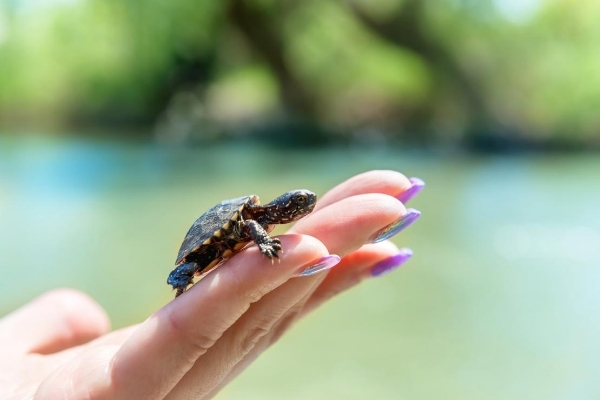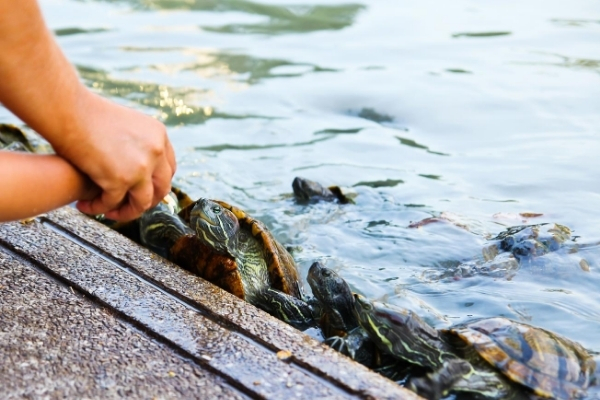Tags:
How To Take Care Of A Baby Turtle In The Winter?


fact checked & review by
Dr. Partho Kumar Shaha
Veterinarian (DVM)
The information is current and up-to-date in accordance with the latest veterinarian research.
Winter gives a hard time for most of the turtle species. Most young and adult turtles can survive the cold if you offer them excellent care. But the low temperature can be an issue for the baby turtles. Some of the newborns do not have a defense mechanism and fall sick easily due to the weather. Hence, as a turtle owner, it is your responsibility to provide the hatchlings extra care throughout the winter.
Many baby turtles cannot survive through the hibernation process. So, never think of letting your hatchlings to hibernate. Instead, prepare a winter enclosure for them. Set up a water heater, basking dock, heating light, and UV bulb so that the babies do not feel cold.
If you have baby turtles and are looking for their winter care, then this is the article you need. In this article, I will illustrate how you can make the newborns survive the winter. You will also learn why hibernating is not a good option for the hatchlings and how they overwinter in the wild.
Aquatic Turtle Care Sheet

For a printable version of this amazing care sheet, click here.
Is Hibernation Dangerous For Baby Turtles? Why?
Researchers have claimed that hibernation can be harmful or dangerous for baby turtles. Before telling you the reasons, allow me to tell you what this is. I am sure most of you know more or less about the process. Let me clear the facts for those who do not know about the hibernation.
Turtles are ectothermic or cold-blooded species. It means a turtle can not generate heat inside its body and depend on the temperature of the enclosure or environment. Simply, you can put it this way. If the temperature outside is 50 degrees Fahrenheit, so will be the temperature of the turtle’s body.
So, when the winter comes, and the turtles do not get enough heating source, they start slowing down their metabolism. They become dependent on the energy stored from the previous digestion. To minimize energy consumption, the species decreases its cardiac and heart rate by 80%.
The hibernating turtles become sluggish and inactive. They refuse to eat and drink sometimes. Most of the turtles hibernate at the bottom of the lake and intake oxygen through their skins.
I am explaining these again so that you can get a clear concept about the baby turtles and hibernation. If you think properly, you will find out why the process is not suitable for hatchlings. Here are some of the reasons:
- During the hibernation process, the turtles survive on their stored energy. Unfortunately, the baby turtles can not survive 2 to 3 months without eating any food.
- The hibernating turtle stays at the bottom of the lake and absorbs oxygen through its skin and butt. If the habitat becomes low in oxygen content, some turtles survive on no oxygen. A baby turtle’s body is not well developed for this type of oxygen absorption. The newborns can drown to death.
- The baby turtle’s body does not have a defense mechanism against winter diseases. As a result, babies can die during hibernation.
Experts think that hibernation is not only dangerous for baby turtles but also the young ones. The process can hamper the natural growth of a hatchling. Never hibernate in their first year. When your baby turtle turns 3, you can think about hibernating it with a vet’s permission.
Baby Turtle Winter Care
As you can see, hibernation is too dangerous for baby turtles, so this should not be an option. So, how can you assure the best care for the babies in winter? The answer is simple. You just need to set up the baby turtle’s enclosure in such a way that the pet can not feel the temperature fall.
In the next section, I will share how you can make your baby turtle’s habitat perfect for the winter.
Baby Turtle’s Winter Enclosure
To prepare your baby turtle’s enclosure suitable for winter, you need to bring some modifications to the existing setup. Such as:
- Selecting the perfect tank
- Installing a tank heater
- Providing heating lamp
- Setting up a UV bulb
Choose The Perfect Tank For Winter
In the summertime, you have the full freedom to raise your turtle in either an indoor or outdoor enclosure. But, when it comes to winter, you should not risk putting the babies in an outdoor pen.
Many turtle owners think if you crowd the babies in a single enclosure, it will keep them warm. It is incorrect and can harm your pet’s health. You can use the same tank you were using before.
A 55 gallon tank will be good for 2 or 3 baby turtles with a length of 6 to 8. On the other hand, a 30 gallon tank will work perfectly for 4 to 6 inches baby turtles. Crowing the babies in one pen is not a good idea. Try not to put more than 3 newborn turtles in a medium-sized enclosure.
If your region gets too cold during the winter, you can cover the tank glass with an insulating material. But before taking any step, must consult with the vet.
Install A Tank Heater
Like the adult turtles, the baby turtles also need heat to stay warm underwater. Even, by comparing to the adult ones, the hatchlings can be more vulnerable. It is because their body and defense against the diseases are not well developed.
The best way to keep the water warm is to install a water tank heater in the enclosure. The heater makes sure the water temperature does not drop and stay suitable for the baby turtles. You may not need to use a tank heater in the summer or spring, but it is a must for the winter. Also, during that period, the heater must be on 24/7.
Now people often get confused while choosing the right power heater for the tank. For your convenience, I am adding a chart below.
Water heater power according to the size of the enclosure:
| Tank Size | Power Of The Water Tank Heater |
|---|---|
| 20 gallon | 75 watt |
| 40 gallon | 150 watt |
| 65 gallon | 250 watt |
| 75 gallon | 300 watt |
This measurement is ideal for both adult and baby turtle’s enclosure. If your pen is 100 gallons, use two tank heaters with 300 watts and 75 watts. You can use multiple heaters in the baby turtle’s tank, which is actually a good decision. This can work as a back up if one of the heaters breaks down.
You will find various types of heater available in the market. Some owners prefer the cheap one as they cost less money. But wait, those low-quality water tank heaters can not provide top-notch service. From time to time, the heater can stop working, and the tank temperature drops. So, the baby turtle starts slowing down its metabolism to cope with the environment.
The heater can sometimes raise the water temperature so high that it becomes unbearable for the baby turtles. So, they come out of the water and stay on the dock. That is why I discourage to buy low-quality stuff.
Instead of buying cheap heaters, invest your money in automatic tank heaters. I know they are a bit expensive but provide the best service and last a long period. Again, these heaters can track down the water temperature and not let it drop or rise too much.
You can check this article to learn the types of tank heaters and which one is the best for your baby turtles. However, while choosing the heater, examine its design and materials carefully. Make sure that the pet will not get hurt by it.
One more thing you must set up with a tank heater is a thermometer. You can measure the tank temperature just by looking at the machine. You can use either an analog or a digital one.
Provide A Basking Lamp
A basking lamp is one of the essential elements for a baby turtle’s enclosure. But many owners use LED as an alternative. Well, if you are one of them, please switch to the proper basking lamp at least during the winter.
Whether your baby turtle is aquatic, semi-aquatic, or land species, maintaining the dock’s temperature is always essential. An aquatic baby turtle comes to the dock from time to time. They bask in the heat, soak their bodies, and sometimes they sleep there.
If you can not provide a warm basking station during the cold, the pet will not come out of the water. And when they spend too much time underwater, their baby shells will start growing fungus. The babies will also suffer from respiratory, cold diseases, and shell problems. Do you think the newborns can survive these severe conditions?
Well, basking lights are not much expensive. If you show ignorance in this matter, it can cost your pet’s life. That is why I suggest you set up a good quality basking lamp in the baby turtle’s enclosure.
In the cold season, keep the basking light on 24/7. The hatchlings need the heat to beat the severe cold. But keeping the light on at night can mess with the baby turtles’ sleeping cycle. For the night time, you can use a red light bulb.
The red bulbs can emit a considerable amount of heat without exhibiting visible light. If you are looking for other options, then read this article. You will get a clear idea of how to choose the right basking lamp for the baby turtles.
Set Up A UV Lamp
A UV lamp emits two basic rays, UVA and UVB. Both exposures play significant roles in baby turtles’ life. How? Let me explain it to you.
Like adult turtles, babies can not absorb vitamin D and calcium directly from the food. They need an external source for that. UVB exposures can generate vitamin D3 inside the hatchling’s body and help them consuming calcium. Both the nutrients are essential for shell and bone building for the babies.
Without the vitamin D3 and calcium, the babies will suffer from metabolic bone diseases. You already know the baby turtles become vulnerable in the cold. You do not want them to suffer more.
Again, UVA exposure is not less important than UVB. This ray helps the babies to have a perfect mental state. The cold can affect the babies’ activity and make them sluggish. Without the UVA, the hatchlings may suffer more.
Many owners use the sun as the source of UV rays. But in the winter, the sun can not be an option. If you do not want your turtle hatchlings to suffer, set up a quality UV bulb inside the enclosure. Keeping the UV bulb on only for 8 to 12 hours will work.
If you want to buy new UV light, give a read to this article. You will get to know the variations, pros, and cons of each UV bulb from here.
What Is The Suitable Temperature For Baby Turtles In Winter?
I have discussed how you can maintain the perfect temperature inside the baby turtle’s enclosure. But do you know what a suitable temperature for your hatchlings is? Take a glance at the chart given below:
| Water Temperature | Basking Temperature |
|---|---|
| 78 to 82 degrees Fahrenheit | 85 to 90 degrees Fahrenheit |
The given temperature can vary depending on the species of your baby turtle. If you can maintain the temperature, your baby turtles will barely realize the change in the weather. Hence, their daily life will not change.
Additional Care Tips For Baby Turtles During Winter
If you can provide all the things I have mentioned above, your baby turtles will survive the winter perfectly. Here are some additional tips you can follow to keep them more active and healthier:
- A dirty enclosure can cause skin and shell problems to the baby turtles. To keep the water clean and hygienic, set up a water filter inside the habitat.
- No matter which species you are raising, provide both land and water areas.
- The baby turtles can not hold their breath for too long under deep water. So, make sure the water level is not dangerous for them.
- During winter, the tanks or lakes can be low in oxygen content. As a result, the babies may leave the water for a long time. To avoid the problem, step up an air stone or pump inside the enclosure for oxygenation.
- Putting a thick layer of substance will be a great idea. The baby turtles can burrow inside the substrate if necessary.
Eating Habit Of Baby Turtles In The Winter
The baby turtles will only stop eating if you fail to provide them with the perfect temperature. Due to the cold, they will start slowing down their metabolism and preparing to hibernate.
If your baby turtles are still eating, then feed them a balanced diet. The baby turtles need more nutrition than the adult ones because they are in their development age. Here is a food list you can follow:
- Green leafy vegetables
- Romaine lettuce
- Spinach
- Feeder fish
- Flake
- Pellets
- Turtle sticks
- Mealworms
- Earthworms
- Black worms
- Water hyacinths
- Shrimp
- Grapes
- Melons
- Apples
- Strawberries
- kale
You have to ensure that each meal has a balanced portion of meat and veggies. To fulfill the lack of vitamins, sprinkle vitamin D, and calcium supplements on each meal. After providing food, make sure the babies are eating.
However, the diet chart can vary from species to species. Before making the meal plan for your hatchlings, determine its species or subspecies.
If your hatchlings are not still eating even after providing the perfect temperature, there can be two reasons. They can either be sick or bored with typical meals. So, consult a vet as soon as possible, and bring varieties in the diet chart.
Baby Turtle’s Health During The Winter
The baby turtles can be very sensitive. They can fall sick even if they are exposed to a little cold. That is why you have to ensure the best care for the hatchlings.
The signs of sickness can be:
- Loss of appetite
- Inflammation
- Fluid discharging from mouth, eyes or nose
- Sleeping too much
- Laying inactive on the dock
If you notice any abnormal behavior from the baby turtle, isolate it immediately. Take it to a vet for better treatment.
How Do The Baby Turtles Survive Winter In The Wild?
The wild baby turtles are survivors by born. They adopt some changes to beat the severe cold. For example, most gravid turtles lay their eggs in late autumn. They lay eggs by digging a hole in the soil and cover it with dirt. The newborn baby turtles do not come out of the nest until the next spring, even after the hatching. They stay in the hole under the soil, and this process is called overwintering in the nest.
In some areas, the soil temperature can drop below 25 degrees Fahrenheit. In those regions, the baby turtles have a different type of body composition. They own more body fats and oils than usual. Those fatty tissues help the baby turtles to survive the winter.
You will be surprised to know that many baby turtles can produce anti-freezing compounds during the winter. If you compare your pet hatchlings with the wild ones, then it will be a mistake. The wild turtles born with more survival instincts than the captive ones.
Frequently Asked Questions
Do Baby Turtles Hibernate?
Some baby turtles hibernate. Hibernating baby turtles can survive from late summer to the following spring on their own fat reserves, without eating. This added energy easily gets them through a long, cold winter. However, not all turtle species hibernate.
Do Baby Turtles Need To Stay Warm?
Baby turtles need to stay warm. A heating lamp in the enclosure is needed to keep the temperature around 85 degrees Fahrenheit.
Do Baby Turtles Need Sunlight?
Baby turtles need sunlight in the wild as sunlight provides vitamin D3 to their bodies. However, in captivity, you can use UVB light for providing vitamin D3 instead of natural sunlight.
Conclusion
Baby turtles are sensitive and less tolerant than the adult one. Some of them may not survive the winter without proper care. In this article, I tried to illustrate all the important information you may need to keep your hatchling healthy in winter. So, ensure the best care and let me know if I have missed any point.

About Author
Muntaseer Rahman started keeping pet turtles back in 2013. He also owns the largest Turtle & Tortoise Facebook community in Bangladesh. These days he is mostly active on Facebook.
Disclaimer
This site is owned and operated by Muntaseer Rahman. TheTurtleHub.com is a participant in the Amazon Services LLC Associates Program, an affiliate advertising program designed to provide a means for sites to earn advertising fees by advertising and linking to Amazon.com. This site also participates in other affiliate programs and is compensated for referring traffic and business to these companies.






